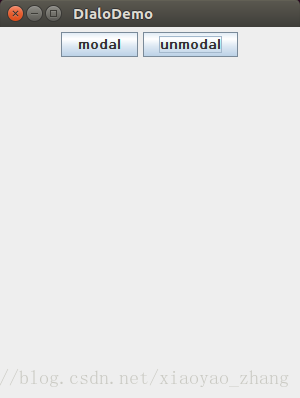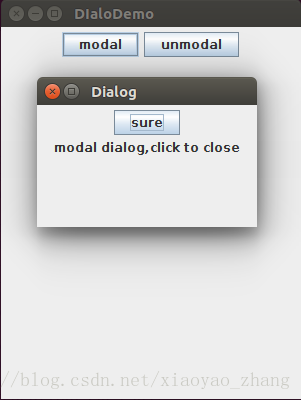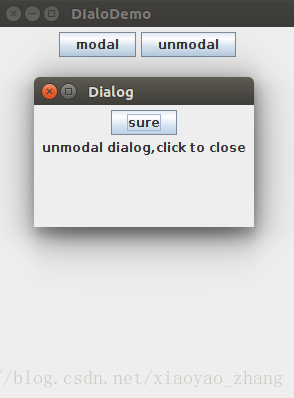import java.awt.*;
import java.awt.event.*;
import javax.swing.*;
public class dia
{
public static void main(String args[])
{
JButton btn1=new JButton("modal");
JButton btn2=new JButton("unmodal");
JFrame f=new JFrame("DIaloDemo");
f.setSize(300,400);
f.setLocation(300,200);
f.setLayout(new FlowLayout());
f.add(btn1);
f.add(btn2);
f.setDefaultCloseOperation(JFrame.EXIT_ON_CLOSE);
f.setVisible(true);
final JLabel label=new JLabel();
final JDialog dialog=new JDialog(f,"Dialog");
dialog.setSize(220,150);
dialog.setLocation(350,250);
dialog.setLayout(new FlowLayout());
final JButton btn3=new JButton("sure");
dialog.add(btn3);
btn1.addActionListener(new ActionListener(){
public void actionPerformed(ActionEvent e){
dialog.setModal(true);
if(dialog.getComponents().length==1){
dialog.add(label);
}
label.setText("modal dialog,click to close");
dialog.setVisible(true);
}
});
btn2.addActionListener(new ActionListener(){
public void actionPerformed(ActionEvent e){
dialog.setModal(false);
if(dialog.getComponents().length==1){
dialog.add(label);
}
label.setText("unmodal dialog,click to close");
dialog.setVisible(true);
}
});
btn3.addActionListener(new ActionListener(){
public void actionPerformed(ActionEvent e){
dialog.dispose();
}
});
}
}







 本文通过一个Java Swing应用程序演示了如何创建模态和非模态对话框。程序中包含两个按钮,分别用于显示模态和非模态对话框,并且可以通过点击“sure”按钮关闭对话框。
本文通过一个Java Swing应用程序演示了如何创建模态和非模态对话框。程序中包含两个按钮,分别用于显示模态和非模态对话框,并且可以通过点击“sure”按钮关闭对话框。
















 891
891

 被折叠的 条评论
为什么被折叠?
被折叠的 条评论
为什么被折叠?








